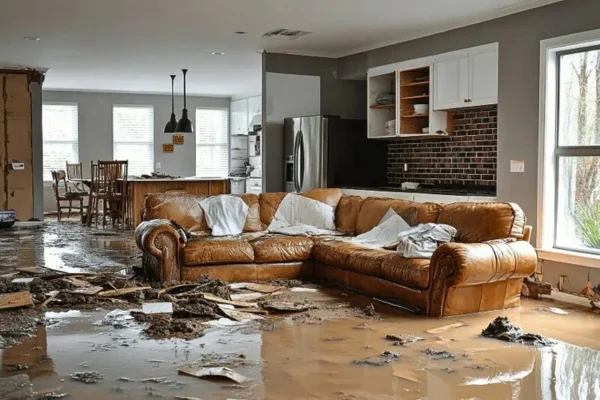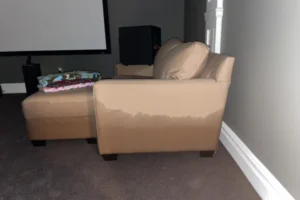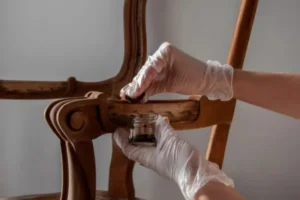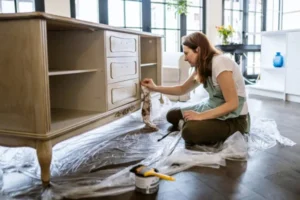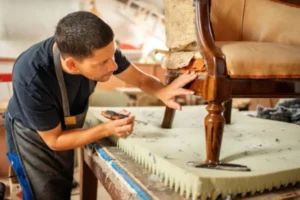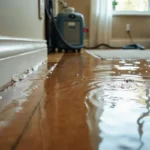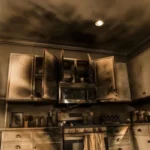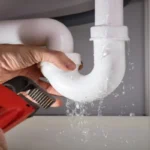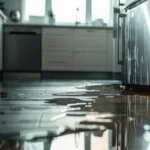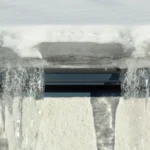Restoring water-damaged furniture starts with quick action. First, assess the extent of the damage. Dry the piece thoroughly to prevent mold and warping. For wood, sanding and refinishing may be needed; for upholstery, deep cleaning or replacement might be required. Each material responds differently, so using the proper technique is key to successful restoration.
Skilled techniques can restore water-impacted furniture to its former beauty. Whether you’re tackling furniture water damage or need help refinishing furniture damaged by water, professional care makes all the difference. Here’s what you should know to get started:
Understanding Water Damage to Furniture
Water damage can sneak up on you in many ways, from spills to leaks. Knowing what causes this damage and how to spot the signs is essential for protecting your furniture. Let’s explore the common culprits and indicators of water damage to keep your pieces looking their best.
What Causes Water Damage in Furniture?
Water damage can ruin furniture’s appearance and structure. Here are typical culprits:
- Spills and Leaks: Accidental spills or plumbing leaks can soak into wood and upholstery.
- High Humidity: Moist air causes swelling, warping, and mold growth.
- Flooding: Severe water exposure leads to rot and structural damage.
- Improper Drying: Furniture made from poorly dried wood is more susceptible to damage.
- Condensation: Trapped moisture under glass or metal surfaces can cause staining or corrosion.
Understanding these causes helps prevent and restore water-impacted furniture before it deteriorates further.
Signs of Water Damage on Different Types of Furniture
Spotting early signs of water damage can help you save your furniture from costly repairs. Watch for:
- Wood: Swelling, warping, soft spots, or peeling finishes.
- Upholstery: Stains, mildew, musty odors, or damp fabric.
- Metal: Rust spots, bubbling paint, or flaking surfaces.
- Glass: Cloudiness or persistent water spots.
These indicators suggest moisture has penetrated the material. If you notice any of these, act quickly to prevent further deterioration and preserve your water-damaged furniture’s integrity and appearance.
Steps to Restore Furniture Damaged by Water
To restore water-impacted furniture, you first need to assess the extent of the damage. Once you’ve determined the extent of the damage, you can proceed to clean and dry the affected areas. These steps are essential for salvaging your furniture and preventing further issues.
Assessing the Extent of the Damage
Inspect surfaces for warping, bubbling, or discoloration. Check joints for looseness and press on wood for softness—signs of structural compromise. Look underneath for hidden mold or mildew. Peeling finishes suggest deep moisture penetration.
The longer the exposure, the worse the damage. A thorough assessment helps determine whether you can restore water-damaged furniture or need professional help.
Cleaning and Drying Water-Impacted Furniture
Move furniture to a dry, ventilated area. Blot excess moisture with soft cloths—never rub. Disassemble parts, such as drawers, to aid airflow. Use fans or dehumidifiers to accelerate the drying process.
Treat mold with water and vinegar. Once dry, inspect for lingering damage. Refinishing or sealing may be needed to protect the piece and prevent future water-related deterioration.
How to Restore Water-Damaged Wood Furniture
Restoring water-damaged wood furniture can seem challenging, but with a clear step-by-step guide, you can bring it back to life. From minor stains to structural concerns, managing furniture water damage and refinishing furniture damaged by water keeps your pieces looking their best. Let’s jump into the restoration process and get your furniture looking great again.
Step-by-Step Guide for Wood Furniture Restoration
Restoring wood furniture after exposure to moisture requires care and precision. Follow these steps:
- Wipe Surface: Use a dry cloth to remove excess moisture.
- Air Dry: Place in a ventilated area, away from direct sunlight.
- Assess Damage: Look for signs of warping or staining.
- Heat Treatment: Use a low-heat setting hairdryer to minimize warping.
- Stain Removal: Gently rub with a mixture of vinegar and oil.
- Refinish: Sand lightly and apply matching stain or finish.
- Cure: Let everything dry fully before reuse.
Using Wood Furniture Polish After Water Damage
After drying your water-impacted furniture, applying wood polish can restore its appearance and add protection. Use a polish suited to the finish, and gently rub it in with a soft cloth, following the grain. Let it sit briefly, then buff for a smooth shine. This simple step helps mask minor blemishes and guards against future moisture damage.
Restoring Upholstered Furniture After Water Damage
Upholstered pieces are especially vulnerable to furniture water damage. Acting quickly can prevent mold, stains, and odors from becoming permanent.
How to Dry Water-Damaged Upholstery
Dealing with water-damaged upholstery can feel daunting, but acting quickly makes all the difference. Follow these general steps to help protect and restore your furniture:
- Remove cushions and pillows to prevent trapped moisture.
- Use a wet/dry vacuum to extract as much water as possible from the fabric.
- Blot the upholstery with clean, dry towels to absorb lingering moisture.
- Set up fans around the furniture to improve air circulation and speed drying.
- Place furniture in a shaded area outdoors, if possible, to avoid direct sunlight.
- Check thoroughly for dryness to prevent the growth of mold and mildew.
Cleaning and Deodorizing Upholstered Furniture
After the upholstery is completely dry, cleaning and deodorizing will help bring back its freshness and appearance. Here’s a step-by-step approach:
- Vacuum the upholstery to remove any loose dust or debris.
- Create a mild soap and water solution for gentle cleaning.
- Blot stains with a damp cloth, being careful not to oversaturate the fabric.
- Rinse the cloth in clean water and blot again to remove any soap residue.
- Sprinkle baking soda on the fabric to absorb lingering odors.
- Vacuum up the baking soda after a few hours for a refreshed finish.
- Consider using a fabric-safe cleaner or hiring a professional for stubborn odors.
Restoring Metal Furniture After Water Damage
If you’re dealing with furniture water damage, timely action can help restore water-damaged furniture. Expert methods for refinishing water-impacted furniture can save cherished pieces and maintain home aesthetics.
Metal furniture may resist moisture better than wood or fabric, but corrosion and rust can still occur. Timely care is key to successful restoration.
Treating Rust and Corrosion from Water Damage
To treat rust on metal furniture, gently scrub the affected areas with a mixture of vinegar and water or a rust remover. Use fine steel wool for stubborn spots, avoiding scratches. Rinse and dry thoroughly to prevent further corrosion. Apply metal polish to restore shine. These steps are essential for achieving lasting results when refinishing furniture damaged by water.
Applying Protective Coating for Long-Term Care
After cleaning, apply a rust-inhibiting primer or sealant to protect metal furniture. Ensure surfaces are dry and free of debris. Use a brush or spray for even coverage, and let it cure fully. Reapply annually in humid areas to maintain protection. This barrier helps prevent future damage and extends the lifespan of your furniture.
Preventing Future Water Damage to Your Furniture
To keep your furniture safe from future water damage, it’s essential to take proactive steps.
Tips to Avoid Water Damage in the Future
Preventing furniture water damage requires a proactive approach. Simple, consistent habits can go a long way toward protecting your pieces. Follow these tips:
- Identify sources of moisture, such as leaks, humidity, or condensation.
- Inspect your plumbing and appliances regularly for signs of wear or leaks.
- Use a dehumidifier in damp rooms, such as basements.
- Clean with minimal water, using a wet cloth instead of soaking furniture.
- Position furniture away from windows and doors to reduce rain and humidity exposure
- Elevate or relocate furniture during storms if you live in flood-prone areas.
Using Furniture Covers and Waterproofing Techniques
Adding furniture covers and waterproofing solutions is an effective way to prevent water damage. Here’s how to protect your pieces:
- Invest in high-quality furniture covers, especially for outdoor pieces.
- Ensure covers fit snugly to block moisture, dirt, and debris.
- Apply waterproofing sprays suited for the furniture’s material, such as fabric or wood.
- Create a protective layer with sprays that repel water and prevent absorption.
- Check covers and protective coatings regularly for wear or damage.
- Reapply waterproofing treatments as needed to maintain complete protection.
When to Call a Professional for Water-Damaged Furniture
If your furniture has suffered significant water damage, it is recommended that you call in a professional. Knowing how to choose the right expert can make all the difference in saving your beloved pieces.
Why You Might Need Professional Restoration Services
Severe damage, such as warping, mold, or weakened structure, often calls for expert help. Professionals can assess the situation accurately and apply the proper techniques for safe restoration.
They also save you time and effort if you’re unsure where to start. When in doubt, hiring a specialist helps protect your furniture and prevents additional risks or costly mistakes.
How to Choose the Right Furniture Restoration Expert
Selecting a qualified restoration expert ensures your furniture receives proper care. Look for experienced professionals with positive reviews, certifications, and insurance. Ask about their process, timelines, and costs to avoid surprises.
Viewing previous work or references builds confidence in their abilities. A reliable expert communicates clearly and prioritizes your furniture’s restoration, making the process smooth and stress-free.
Final Thoughts on Restoring Water-Impacted Furniture
Restoring furniture damaged by water can be a manageable task if you act quickly and follow the proper steps. By evaluating the damage, thoroughly drying them, and applying the appropriate treatments, you can bring your beloved pieces back to life.
Remember to take preventative measures to protect your furniture from future incidents. If the damage appears too extensive or you’re unsure how to proceed, don’t hesitate to contact a professional for assistance. Your furniture deserves the best care!
Don’t let water damage ruin your furniture. Get professional help to restore your valuable pieces. Protect your investment by addressing furniture water damage early. Knowing how to restore water-impacted furniture and how to approach refinishing water-damaged furniture is key. Call us today and let our water restoration professionals help you out!

